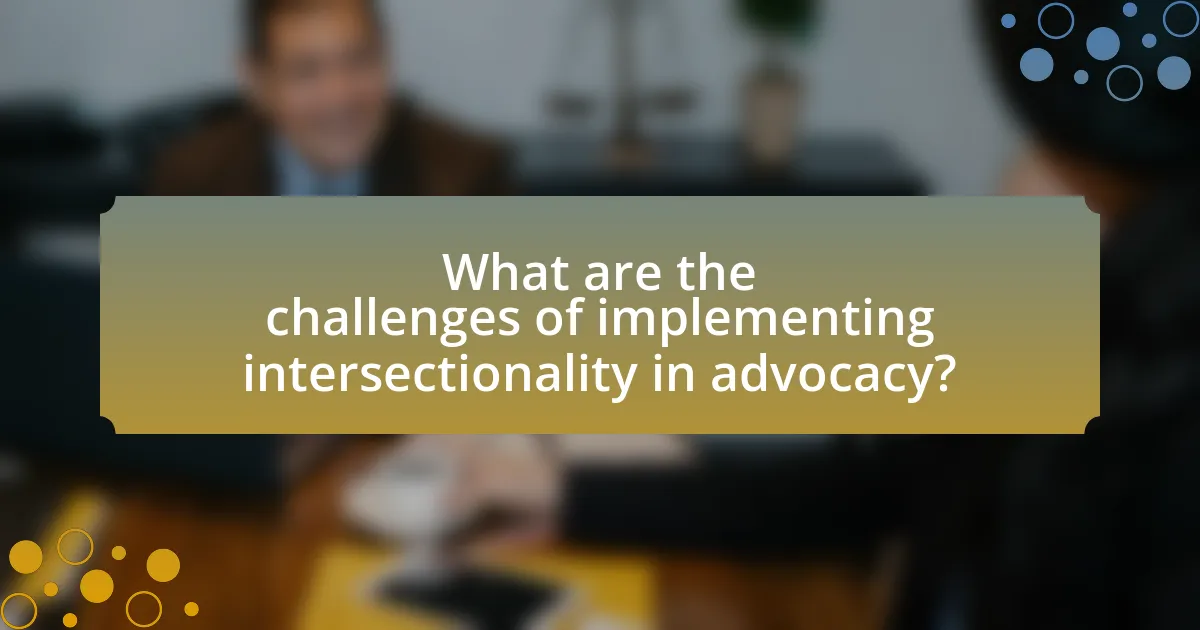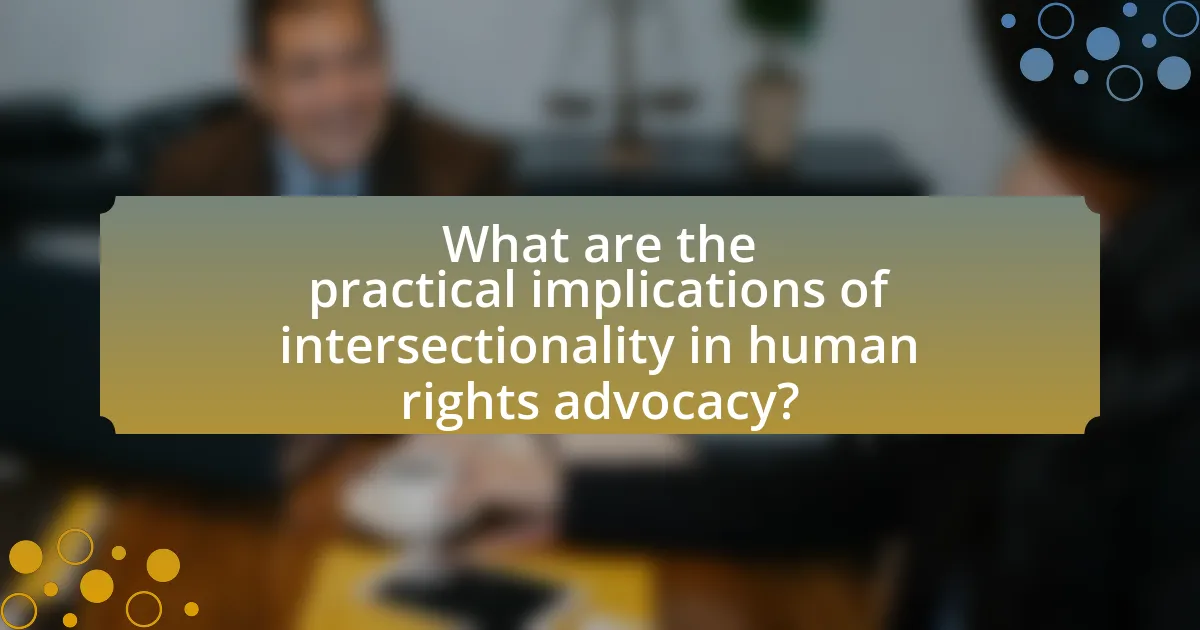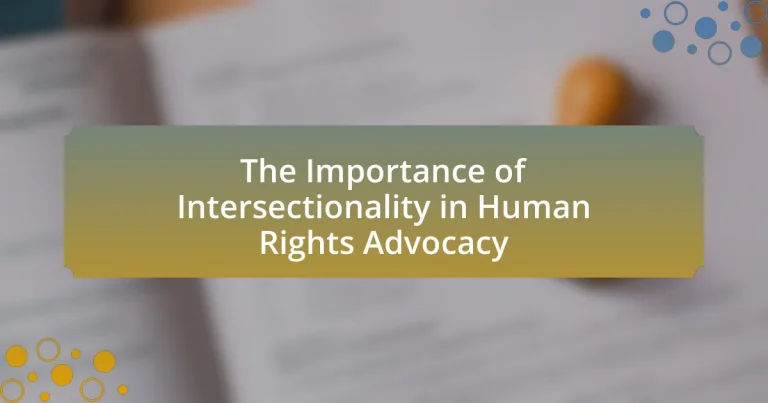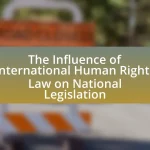Intersectionality in human rights advocacy is a framework that examines how overlapping social identities—such as race, gender, sexuality, and class—interact to shape unique experiences of discrimination and privilege. This article explores the significance of intersectionality in addressing human rights issues, emphasizing the need for inclusive advocacy strategies that cater to the specific challenges faced by marginalized groups. Key components include recognizing systemic inequalities, promoting inclusive policy-making, and understanding the compounded injustices experienced by individuals with multiple marginalized identities. The article also discusses the challenges of implementing intersectionality in advocacy, the importance of funding, and best practices for ensuring inclusivity in initiatives.

What is Intersectionality in Human Rights Advocacy?
Intersectionality in human rights advocacy refers to the framework that examines how various social identities, such as race, gender, sexuality, and class, intersect to create unique experiences of discrimination and privilege. This approach recognizes that individuals do not experience oppression or privilege in isolation; rather, their multiple identities interact in complex ways that affect their human rights experiences. For example, a Black woman may face different challenges than a white woman or a Black man due to the intersection of her race and gender. This understanding is crucial for effective advocacy, as it allows for more comprehensive strategies that address the specific needs of marginalized groups, ensuring that human rights efforts are inclusive and equitable.
How does intersectionality influence human rights issues?
Intersectionality influences human rights issues by highlighting how various social identities, such as race, gender, sexuality, and class, intersect to create unique experiences of discrimination and privilege. This framework reveals that individuals facing multiple marginalized identities often encounter compounded injustices that are overlooked by traditional human rights approaches. For instance, a study by Crenshaw (1989) on Black women illustrates that their experiences cannot be understood solely through the lens of race or gender, but rather through the intersection of both, which leads to specific forms of discrimination that require targeted advocacy. By recognizing these intersections, human rights advocacy can become more inclusive and effective, addressing the needs of the most vulnerable populations.
What are the key components of intersectionality in this context?
The key components of intersectionality in the context of human rights advocacy include the recognition of overlapping social identities, the understanding of systemic inequalities, and the emphasis on inclusive policy-making. Overlapping social identities, such as race, gender, sexuality, and class, interact to shape individual experiences of discrimination and privilege. Systemic inequalities highlight how various forms of oppression are interconnected, affecting marginalized groups disproportionately. Inclusive policy-making ensures that the voices and needs of diverse communities are considered, leading to more effective and equitable human rights advocacy. These components are essential for addressing the complexities of social justice and ensuring that advocacy efforts are comprehensive and representative.
How does intersectionality affect marginalized groups differently?
Intersectionality affects marginalized groups differently by highlighting how overlapping social identities, such as race, gender, sexuality, and class, create unique experiences of discrimination and privilege. For instance, Black women face both racial and gender discrimination, which can lead to compounded disadvantages in areas like employment and healthcare, as evidenced by studies showing that they experience higher rates of unemployment and maternal mortality compared to their white counterparts. This nuanced understanding allows advocates to tailor their approaches to address the specific needs of diverse groups, ensuring that human rights efforts are inclusive and effective.
Why is intersectionality essential for effective advocacy?
Intersectionality is essential for effective advocacy because it recognizes and addresses the interconnected nature of social categorizations such as race, gender, class, and sexuality, which can lead to overlapping systems of discrimination or disadvantage. This approach allows advocates to understand the unique experiences and challenges faced by individuals at the intersections of these identities, leading to more comprehensive and inclusive strategies. For instance, research by Crenshaw (1989) highlights how Black women experience discrimination differently than either Black men or white women, demonstrating that advocacy efforts must consider these complexities to be truly effective. By employing an intersectional framework, advocates can create policies and initiatives that better serve marginalized communities, ultimately promoting equity and justice.
What are the potential consequences of ignoring intersectionality?
Ignoring intersectionality can lead to inadequate and ineffective policies that fail to address the unique experiences of marginalized groups. When intersectionality is overlooked, advocacy efforts may prioritize the needs of dominant groups while neglecting those who face multiple layers of discrimination, such as women of color or LGBTQ+ individuals with disabilities. This oversight can perpetuate systemic inequalities and result in a lack of representation in decision-making processes. For instance, research by the American Psychological Association highlights that failing to consider intersectional identities can exacerbate mental health disparities among marginalized populations. Thus, ignoring intersectionality not only undermines the effectiveness of human rights advocacy but also risks further entrenching social injustices.
How can intersectionality enhance the effectiveness of human rights campaigns?
Intersectionality enhances the effectiveness of human rights campaigns by addressing the interconnected nature of social categorizations such as race, gender, and class, which can lead to overlapping systems of discrimination or disadvantage. By incorporating an intersectional approach, campaigns can better identify and respond to the unique challenges faced by marginalized groups, ensuring that their specific needs and experiences are represented. For instance, the 2015 report by the United Nations Human Rights Council highlighted that intersectional discrimination can exacerbate human rights violations, emphasizing the necessity for tailored strategies that consider multiple identities. This approach not only broadens the scope of advocacy but also fosters solidarity among diverse groups, ultimately leading to more comprehensive and impactful human rights initiatives.

What are the challenges of implementing intersectionality in advocacy?
Implementing intersectionality in advocacy faces several challenges, primarily due to the complexity of overlapping identities and systemic inequalities. Advocates often struggle to address the diverse experiences of individuals who belong to multiple marginalized groups, leading to potential oversimplification of issues. For instance, a report by the American Psychological Association highlights that advocacy efforts can inadvertently prioritize the needs of the most visible or vocal groups, neglecting those with intersecting identities who may face compounded discrimination. Additionally, limited resources and funding can hinder the ability to conduct comprehensive research and outreach that adequately reflects intersectional perspectives. These challenges underscore the necessity for a nuanced approach that recognizes and addresses the multifaceted nature of social justice issues.
What obstacles do advocates face when addressing intersectionality?
Advocates face several obstacles when addressing intersectionality, primarily including a lack of understanding and awareness of the concept among stakeholders. This misunderstanding can lead to oversimplification of complex identities, resulting in inadequate representation of marginalized groups. Additionally, advocates often encounter institutional resistance, as existing frameworks and policies may not accommodate intersectional approaches, limiting their effectiveness. Research by Crenshaw highlights that traditional advocacy often fails to address the unique challenges faced by individuals at the intersections of multiple identities, such as race, gender, and socioeconomic status, which can further marginalize these groups.
How can systemic biases hinder intersectional approaches?
Systemic biases can hinder intersectional approaches by perpetuating inequalities that fail to recognize the interconnectedness of various social identities. These biases often manifest in policies and practices that prioritize certain groups over others, leading to a lack of representation and support for marginalized communities. For example, research by Crenshaw (1989) highlights how Black women face discrimination that is not adequately addressed by frameworks focusing solely on race or gender, illustrating that systemic biases can obscure the unique challenges faced by individuals at the intersection of multiple identities. This lack of nuanced understanding can result in ineffective advocacy and reinforce existing power dynamics, ultimately undermining the goals of intersectionality in human rights efforts.
What role does funding play in supporting intersectional advocacy?
Funding is crucial in supporting intersectional advocacy as it enables organizations to address the complex and overlapping social injustices faced by marginalized communities. Financial resources allow these organizations to conduct research, develop targeted programs, and mobilize grassroots efforts that reflect the diverse needs of individuals at the intersections of various identities, such as race, gender, and socioeconomic status. For instance, a study by the Women’s Funding Network highlights that targeted funding for intersectional initiatives leads to more effective advocacy outcomes, as it empowers organizations to create tailored solutions that resonate with specific community challenges. Thus, adequate funding not only sustains intersectional advocacy efforts but also enhances their impact by ensuring that diverse voices are heard and addressed.
How can advocates overcome these challenges?
Advocates can overcome challenges in human rights advocacy by employing intersectional approaches that recognize and address the diverse experiences of marginalized groups. By integrating perspectives from various identities, such as race, gender, and socioeconomic status, advocates can create more inclusive strategies that resonate with a broader audience. Research by Crenshaw (1989) highlights that intersectionality allows for a deeper understanding of how overlapping identities contribute to unique forms of discrimination, thereby enabling advocates to tailor their messages and actions effectively. This approach not only enhances the relevance of advocacy efforts but also fosters solidarity among different groups, ultimately leading to more impactful outcomes in the fight for human rights.
What strategies can be employed to promote intersectionality in advocacy?
To promote intersectionality in advocacy, organizations can implement strategies such as inclusive coalition-building, comprehensive training on intersectional issues, and the integration of diverse voices in decision-making processes. Inclusive coalition-building involves forming alliances with groups representing various marginalized identities, ensuring that advocacy efforts reflect the complexities of individuals’ experiences. Comprehensive training on intersectional issues equips advocates with the knowledge to understand how different forms of discrimination intersect, enhancing their effectiveness. Additionally, integrating diverse voices in decision-making processes ensures that policies and initiatives are informed by the lived experiences of those most affected, leading to more equitable outcomes. These strategies are supported by research indicating that intersectional approaches lead to more effective advocacy and policy change, as seen in studies by the American Psychological Association, which highlight the importance of considering multiple identities in social justice efforts.
How can collaboration among diverse groups enhance intersectional efforts?
Collaboration among diverse groups enhances intersectional efforts by integrating varied perspectives and experiences, which leads to more comprehensive solutions to social issues. When individuals from different backgrounds—such as race, gender, sexual orientation, and socioeconomic status—work together, they can identify and address the unique challenges faced by marginalized communities. Research indicates that diverse teams are more innovative and effective; for instance, a study by McKinsey & Company found that companies in the top quartile for gender diversity on executive teams were 21% more likely to experience above-average profitability. This diversity fosters a deeper understanding of intersectional issues, allowing for advocacy that is more inclusive and representative of the needs of all affected groups.

What are the practical implications of intersectionality in human rights advocacy?
Intersectionality in human rights advocacy leads to more inclusive and effective strategies that address the diverse experiences of marginalized groups. By recognizing how various social identities—such as race, gender, sexuality, and class—intersect, advocates can tailor their approaches to better meet the specific needs of individuals facing multiple forms of discrimination. For instance, research by Crenshaw (1989) highlights that Black women experience unique challenges that are not fully addressed by frameworks focusing solely on race or gender. This understanding allows for the development of policies and programs that are more equitable and responsive, ultimately enhancing the effectiveness of human rights initiatives.
How can intersectionality inform policy-making?
Intersectionality can inform policy-making by ensuring that diverse social identities and their interconnectedness are considered in the development of laws and regulations. This approach recognizes that individuals experience overlapping systems of discrimination and privilege, which can significantly impact their access to rights and resources. For instance, research by Crenshaw (1989) highlights how Black women face unique challenges that are not addressed when policies focus solely on race or gender in isolation. By integrating intersectional analysis, policymakers can create more equitable and effective solutions that address the specific needs of marginalized groups, ultimately leading to improved social justice outcomes.
What examples exist of successful intersectional policies?
Successful intersectional policies include the United States’ Affordable Care Act (ACA) and the United Kingdom’s Equality Act 2010. The ACA expanded healthcare access, particularly benefiting marginalized groups such as low-income individuals and racial minorities, by addressing systemic barriers to healthcare. The Equality Act 2010 in the UK legally protects individuals from discrimination based on multiple characteristics, including race, gender, and disability, promoting equality and inclusion across various sectors. Both policies demonstrate effective integration of intersectional approaches to address complex social issues, thereby improving outcomes for diverse populations.
How can data collection improve intersectional advocacy efforts?
Data collection can significantly enhance intersectional advocacy efforts by providing empirical evidence that highlights the unique challenges faced by individuals at the intersection of multiple identities. This data enables advocates to identify specific needs and disparities within marginalized communities, allowing for targeted interventions. For instance, a study by the Institute for Women’s Policy Research found that women of color experience higher rates of unemployment and wage gaps compared to their white counterparts, illustrating the necessity for tailored policy solutions. By utilizing data to inform strategies, advocates can effectively address systemic inequalities and promote inclusive policies that reflect the diverse experiences of all community members.
What best practices should advocates follow to incorporate intersectionality?
Advocates should prioritize inclusive representation and actively engage with marginalized communities to incorporate intersectionality effectively. This involves recognizing and addressing the unique experiences and challenges faced by individuals at the intersections of various identities, such as race, gender, sexuality, and socioeconomic status. For instance, research by Crenshaw (1989) highlights how Black women experience discrimination differently than their white counterparts due to the overlapping nature of their identities. By utilizing data and narratives from diverse groups, advocates can create policies and initiatives that reflect the complexities of lived experiences, ensuring that no group is overlooked in the advocacy process.
How can advocates ensure inclusivity in their initiatives?
Advocates can ensure inclusivity in their initiatives by actively engaging diverse communities in the planning and implementation processes. This approach allows for the identification of unique needs and perspectives, which can be integrated into advocacy efforts. Research shows that initiatives that incorporate feedback from marginalized groups are more effective; for instance, a study by the American Psychological Association found that inclusive practices lead to better outcomes in community health initiatives. By prioritizing representation and fostering open dialogue, advocates can create more equitable and impactful programs.
What tools and resources are available for intersectional advocacy?
Tools and resources available for intersectional advocacy include comprehensive training programs, online platforms for collaboration, and research databases. Training programs, such as those offered by the Center for Intersectional Justice, equip advocates with the skills to address multiple forms of discrimination. Online platforms like the Intersectionality Toolkit provide resources for coalition-building and strategy development. Research databases, such as the Human Rights Campaign’s resources, offer data and case studies that highlight the importance of intersectionality in advocacy efforts. These tools collectively enhance the effectiveness of advocacy by promoting a nuanced understanding of how various identities intersect and impact individuals’ experiences with discrimination and inequality.


